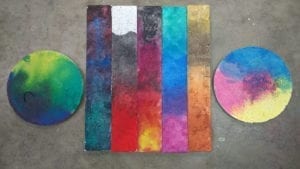Dyes & Glazes
The third method for coloring concrete countertops is by using dyes, also known as glazes. Dyes/glazes, like acid stains, are applied to cured concrete, and they can be applied over integrally pigmented and acid stained concrete. Unlike acid stains, dyes are not reactive. Dyes/glazes are ultra fine particles of color in some kind of liquid carrier, most often water or solvent, such as acetone.
The ultra fine particles “stain” the surface while the liquid carrier quickly evaporates, leaving very little or no residue. This quick evaporation (especially with the solvent based dyes) can be both a benefit and a drawback. Most often they are sprayed on, but they can be brushed, rolled or wiped on. Brushing, rolling or wiping a quickly evaporating glaze will almost always lead to streaks or blotching, so spraying is generally used to ensure an even coloration.
Glzaes can provide a wide range of colors, from duplicating the colors of acid stains to rivaling the colors of integral pigments. Rich, vibrant colors are possible with glazes, and because they can be diluted, mixed and layered, the color possibilities are nearly endless. Like acid stains, glazes are slightly translucent. The finished color is dependent on both the color of the glaze and the color of the underlying concrete.
While glazes provide great versatility, especially when used as an accent or an easy means of coloring specific areas or designs in the concrete, dyes/glazes can be limited to where they can be used. Not all dyes/glazes are UV stable, and some must be used under sealers that block UV light. Water based dyes/glazes tend to be less UV stable and can bleed or smear if a water based sealer is applied over them. Solvent based dyes tend to be more UV stable (but always check with the manufacturer to find where and when to use them), and these too can bleed or smear if a solvent based sealer is applied to them. And like acid stains, dyes/glazes only color the surface of the concrete. Their beauty is only skin deep.
A significant advantage that glazes have over acid stains is that because glazes are not reactive, there is no residue to clean up after the glaze is applied. This means that they can be sealed almost immediately after application (once the liquid carrier evaporates), making the project faster.
And finally, like acid stains, glazes can be very cost effective because a little goes a long way, but again the skill does not come cheap. Glazes are often used by highly skilled artists to create stunning works of art on concrete.
We recommend the Buddy Rhodes Glazes for their range of color options.
Here is an example of some colors and artistic effects you can achieve with glazes:
Conclusion
If you are a homeowner who wants a unique countertop, talk to your local craftsman about the types of coloring options he or she provides.
Whatever look you want to achieve, it is possible with the myriad coloring options for concrete countertops.

